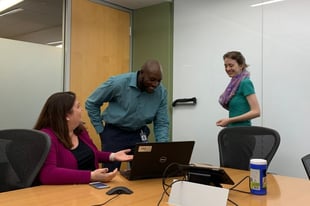What Does Increased Automation and AI Mean for Preconstruction?
Construction has a reputation for a long time as an industry that is steeped in tradition and often resistant to and suspicious of change. But if you’ve been in the industry for any amount of time, you’ll know that this reputation is a little unfair. For centuries, the constant question has been: how can we do this safer, better, and faster than we did last time?
But as deadlines continue to pile up and project owners continue to demand more from general contractors in less and less time, there has become an increased need for reducing or eliminating inefficient processes. How is this done? Usually through automation. When a machine is able to run the numbers you plug in, you cut down immensely on human error, and you also save hours and even days by not having to constantly fix mistakes or process change orders.
The succession to automation is artificial intelligence, also known as AI. The difference between automation and AI is that the former is a type of software that can only follow the rules it’s programmed with, while the latter is software designed to analyze the data it receives and make independent conclusions based on that data.
This sounds incredibly exciting to most people. However, the increased use of these tools has a variety of implications for the future of preconstruction and those who work within it, some good and some bad.
The Negative Implications: Loss of Jobs, High Costs, and Degradation
 Job loss is one of the biggest downsides to the increased use of software automation.
Job loss is one of the biggest downsides to the increased use of software automation.The most obvious downside of automation and AI is that certain roles are significantly diminished—sometimes, they’re eliminated altogether. One study found that up to 30% of jobs will be replaced by automation, and around 36 million workers will lose their jobs as a result of companies implementing AI software.
Additionally, software automation and AI is not a cheap purchase. It’s an expensive, time-consuming investment, and while it can certainly pay off, you still have to balance the rewards with the risk of learning the software, finding people to run and maintain it, and having resources diverted to implementation and training. You may also have to invest in infrastructure to be able to even house such software, such as extra servers to store all your necessary data. Software is increasingly moving to “the cloud,” but that still has storage capacities too.
Last, but certainly not least, these types of software are just as prone to becoming broken-down and outdated as anything else—and in fact, as the rate of technological development continues to speed up, software can easily become irrelevant in a matter of months.
But don’t fear, though: the implications aren’t all terrible.
The Positive Implications: More Time for Higher-Level Activities, Talent Attraction + Retention, and Mitigate Risk
There are plenty of positive implications that the adoption of AI and automation has for the future of preconstruction, and when it’s used wisely, it can truly enhance a company’s existing estimating efforts.
The first great benefit? Saved time. Who doesn’t want hours back in their day? When you save time, you now have more time to do the things you couldn’t before. Some of these are simple, like getting home in time to have dinner with your family or attend your daughter’s softball game. Others have more to do with the growth of your preconstruction team. One of these things—and one that we’ve written about quite a bit—is being able to spend more time focusing on high-level activities. These activities include project pursuit and data analysis. When you’re able to start analyzing your data instead of just generating it, your predictions become more accurate, your reputation becomes more trustworthy, and your portfolio expands.
 On the flip side, using software automation and AI in your workflows can be a huge draw for potential employees.
On the flip side, using software automation and AI in your workflows can be a huge draw for potential employees.Secondly, introducing more automation into your preconstruction workflows is actually a huge help in talent attraction and retention. New graduates want to be able to see that you’re a company that isn’t interested in stagnating, and one of the ways they’ll gauge that is by seeing how open you are to new processes and technologies. Additionally, talent retention gets boosted when your employees discover they don’t just have to exist as human calculators—they can branch out into other specialties. One of the greatest struggles in preconstruction at the moment is finding senior talent, and by creating more specialized roles within your preconstruction department, you have more opportunities to grow junior talent into senior talent instead of having to rush to backfill employees who are ready to retire.
Finally, one of the biggest reasons that software automation and AI has taken off so strongly is that it provides huge risk mitigation when it comes to your estimating efforts. You want all of your estimates to predict the total cost of a project as accurately as possible, and you don’t want to have to constantly go back to adjust for errors or change orders. Even if you only implement software automation into your estimating workflow, you’ll cut back drastically on inefficiencies and save both the project owner and yourself money.

-1.png?width=112&height=112&name=image%20(4)-1.png)














